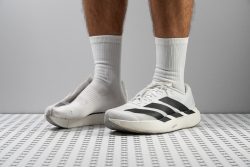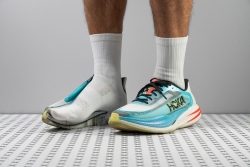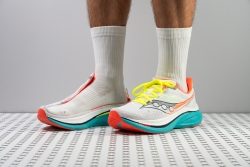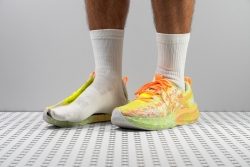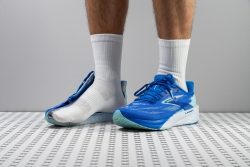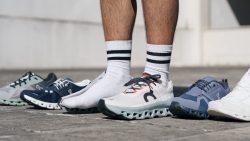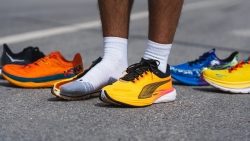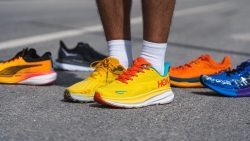7 Best Tempo Shoes in 2025

We buy shoes ourselves. We earn commissions when you buy through us, at no extra cost. Why trust us
Speed is a huge part of running. Whether you’re running easy or fast, your running shoes should match your pace. Just because they are closer to race shoes than daily trainers does not mean they can't overlap with daily trainers as well.
There are many features to look for in tempo shoes, and we covered them all in this guide! We also wrote about what makes the shoes fast, types of foam, plates, how to find shoes for tempo work, what you can live without when prioritizing speed, and so on. If you're feeling nerdy, read on.
Thanks to all the wear tests and lab tests we did on tempo shoes, we chose top picks in different categories. Here, we highlight them and elaborate on why they deserve to be at the top!
How we test tempo shoes
Before they make it to the list, each tempo trainer goes through a myriad of tests in our own RunRepeat shoe testing facility. And to stay objective, we buy them with our own money.
To step it up, we also:
- Run in them in different conditions, both on the treadmill and outdoors. We do many pace variations to accurately sense when the shoes work well and what they're not able to do.
- Cut the tempo shoes open. We examine and measure their parts and features using different tools, including durometers, calipers, tire tread gauges, smoke machines, and Dremel. We do this to back our assumptions and observations up with hard pieces of evidence.
- We publish all the data, along with our first-hand experience, in our in-depth reviews. We also make all the shoes comparable by 20+ metrics such as energy return, shock absorption, traction, breathability, and so on.
Best tempo running shoes overall
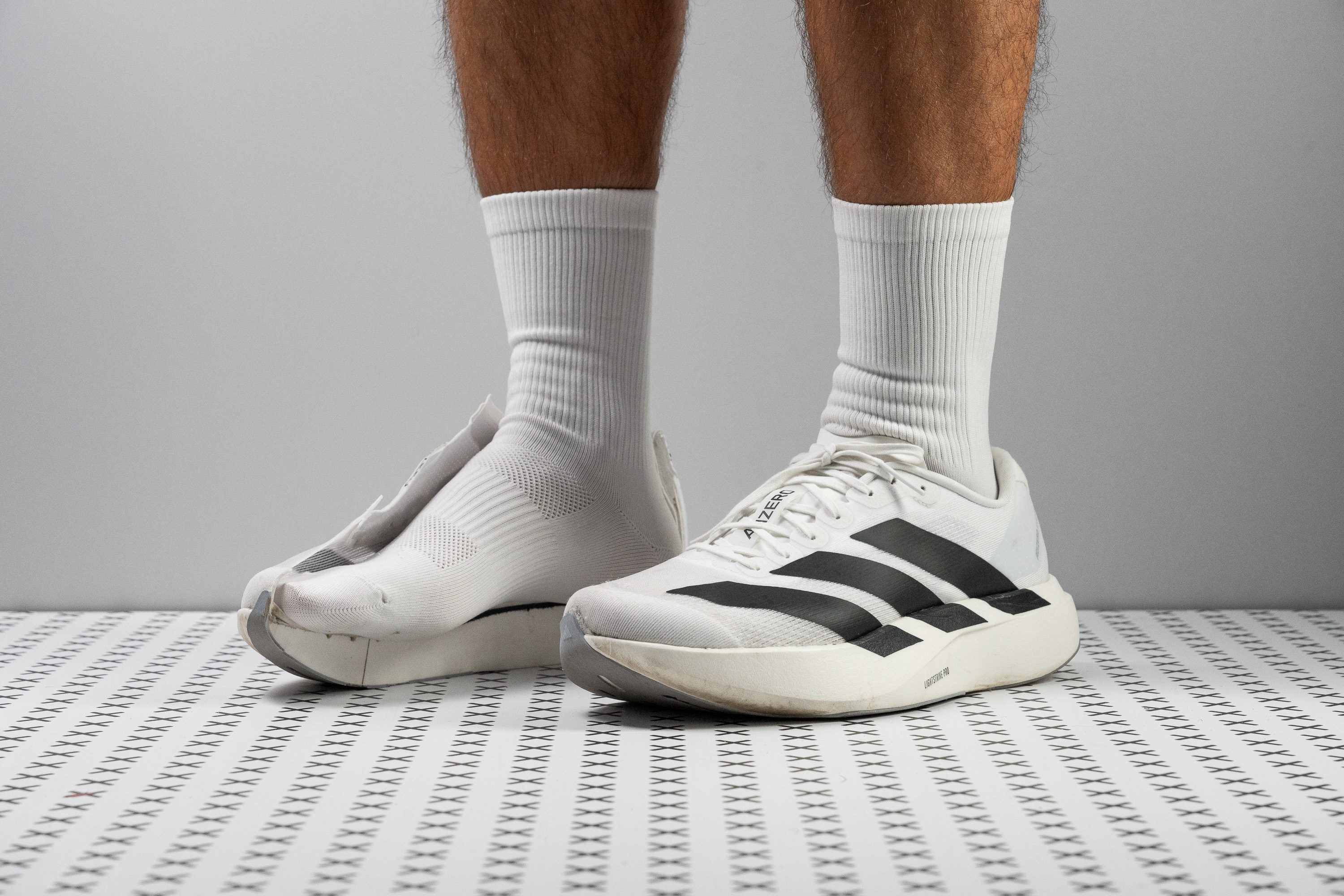































































What makes it the best?
With energy in its DNA, the Adidas Adizero EVO SL takes the trophy as our top tempo trainer. Feeling extremely light in our runs, its Lightstrike Pro midsole took us fast while its shock-absorbing nature took us far. As our lab results reveal, its versatile nature makes it suitable across various run training.
EVO SL is the perfect high-performance trainer, sustaining our speed without the stiffness because it’s non-plated. Instead, it generates responsiveness through its midsole, which recorded high energy return scores of 74.3% in the heel and 70.3% in the forefoot.
With every powerful takeoff, a gentle cushion awaits. It took care of our feet no matter where we land, backed up by its high shock absorption scores of 147 SA in the heel and 126 SA in the forefoot.
Running in the EVO SL feels like we’re floating. Our scale reveals it’s a mere 7.9 oz (223g), 12.9% below average. Plus, it bends freely with our feet, confirmed by our 30-degree test with a 34.7% higher flexibility score than average.
However, we caution that the tongue isn’t gusseted. While it’s not a big issue, it may be an annoyance for some runners.
Pros
- 100% Lightstrike Pro superfoam
- Exceptional value-to-performance ratio
- Low weight
- Ultra-breathable upper
- Unmatched versatility
- Agile and fun ride
- Handles short and long runs with ease
- Striking Evo 1-inspired aesthetics
Cons
- Poor-quality laces
- Short, non-gusseted tongue
- Toebox durability
Tempo running shoes with best energy return
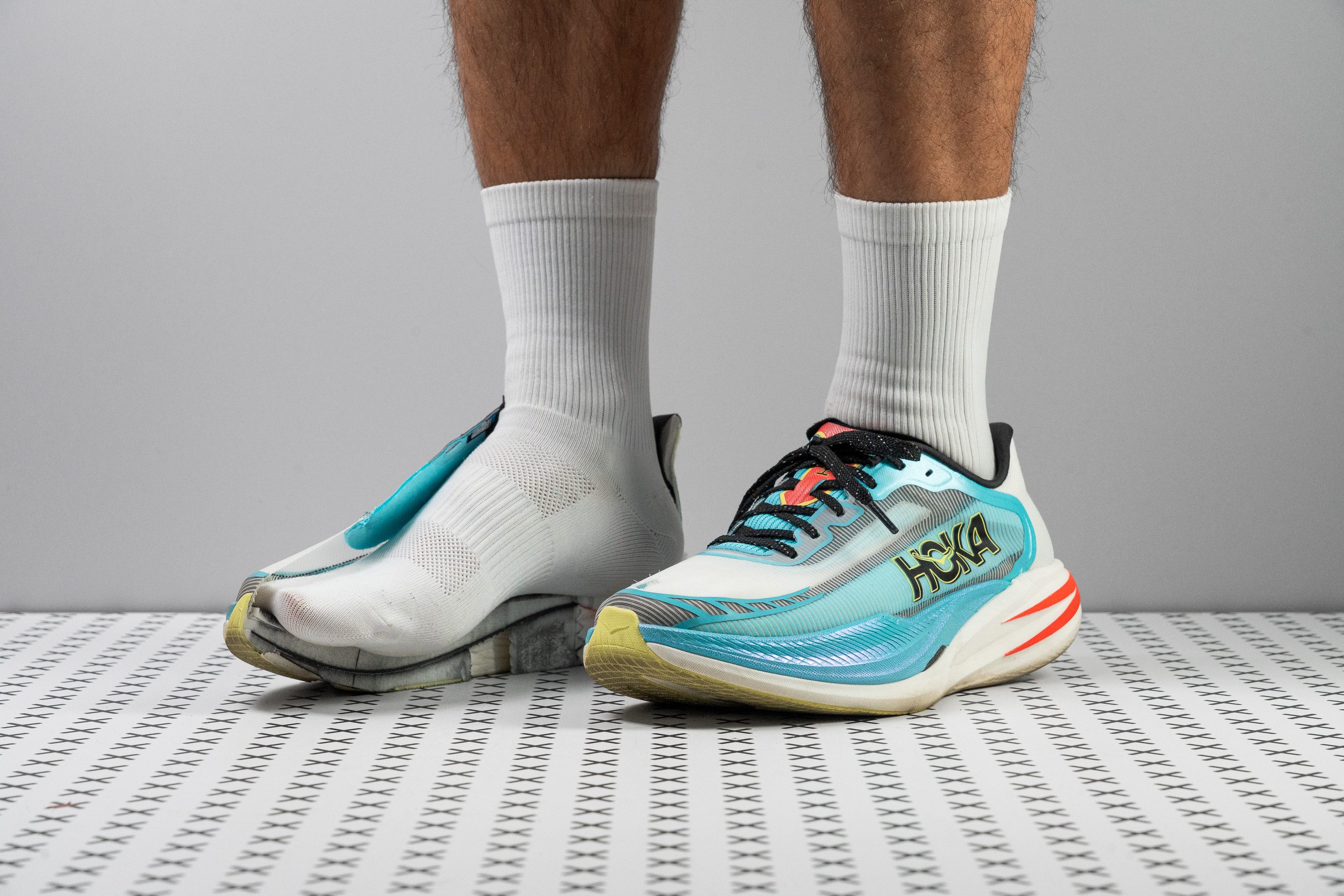

















































What makes it the best?
The HOKA Cielo X1 2.0 is loaded with deep cushioning and powerful rebound, packed in an ultralight design. We enjoyed how it’s so easy on the feet yet heavy on performance, impressing us inside and outside of the lab with the best energy return for tempo running.
The midsole feels electric, and we wanted to quantify the responsiveness we felt. In our energy return test, we recorded a massive 75.9% in the heel and an even higher 78.4% in the forefoot. The midsole has a stiff carbon plate in between to further add vibrance to our strides, while the aggressive rocker drives us forward and improves turnover.
To soften the blow of landings, Cielo X1 2.0 has a luscious 38.8/28.1 mm stack. Not only is it tall, but it’s able to reduce impact better than average with its impressive shock absorption scores of 160 SA (heel) and 108 SA (forefoot).
Surprisingly, we maintained our agility and speed through its airy build. Our scale shows it’s only 7.3 oz (208g), 21.5% lighter than average.
Note that this shoe feels far from stable, so those seeking extra guidance should skip this pair.
Pros
- Much lighter than v1
- Plush and responsive PEBA foam
- Top-tier breathability
- Forked plate adds heel flex
- Comfort-focused heel padding
- Outsole durability is not a concern
- Improved upper and laces
- Works well from 5K to the marathon
- Premium TPEE insole
Cons
- Pricier than most rivals
- Rocker can feel too aggressive
- Narrow-fitting upper
Tempo running shoes with best shock absorption
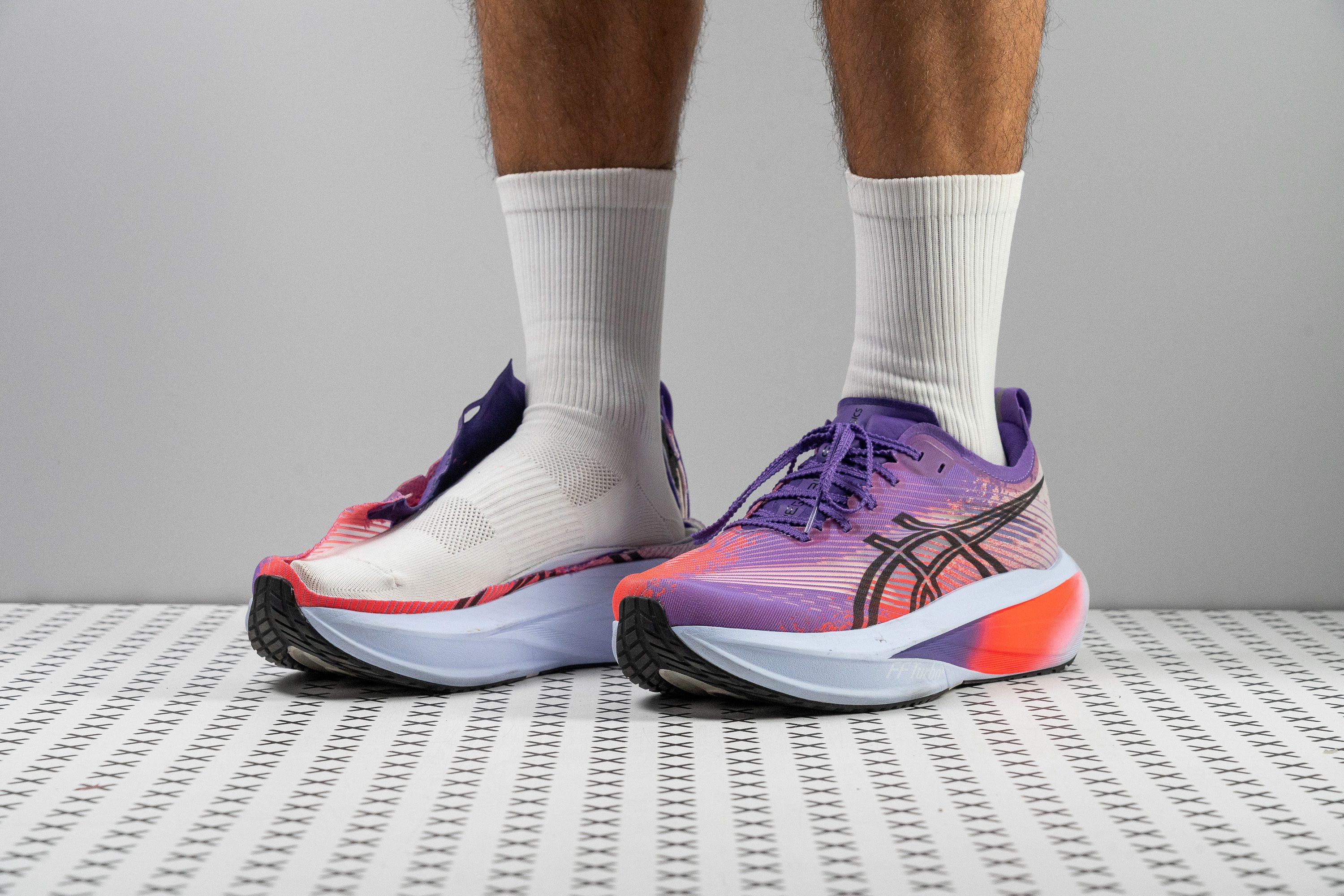
















































What makes it the best?
The ASICS Megablast is living proof that speed and comfort can seamlessly blend. A remarkable foam delivers boundless energy beneath our feet while its leg-saving cushioning and light build provide much-needed relief to ease out the most brutal speed sessions. Our lab results back up that the Megablast is the best shock-absorbing tempo running shoe.
The cushion dampens impact effectively with every stride, validated by its impressive 160/144 SA score in the heel and forefoot, indicating Megablast lessens the load on our legs by 24.0% and 35.8% better than average, respectively.
Testing for the midsole’s energy return, the heel scored 73.0% and the forefoot 73.8%! These remarkable figures indicate propulsive takeoffs, and our feet wholeheartedly agree.
What’s amazing is how the comfort and pop don’t fade away as we run longer miles, making the ride all the more enjoyable. Its pleasant sensation is further enhanced by its light 7.8 oz (218g) construction, allowing us to pick up the pace easily.
Because the Megablast has so much to offer, it comes with a mega price tag of $225. Runners who are not willing to indulge can find more affordable alternatives elsewhere.
Pros
- Outstanding energy return
- Exceptional impact protection
- Durable, grippy outsole rubber
- Astonishingly low weight
- Performs at any pace and distance
- Breathable, lightweight upper
- High-quality materials from heel to toe
- Suitable for all footstrikes
- Top performance without a carbon plate
Cons
- Extremely expensive for a training shoe
- Limited outsole coverage
- Poor toebox durability
Best lightweight tempo running shoes
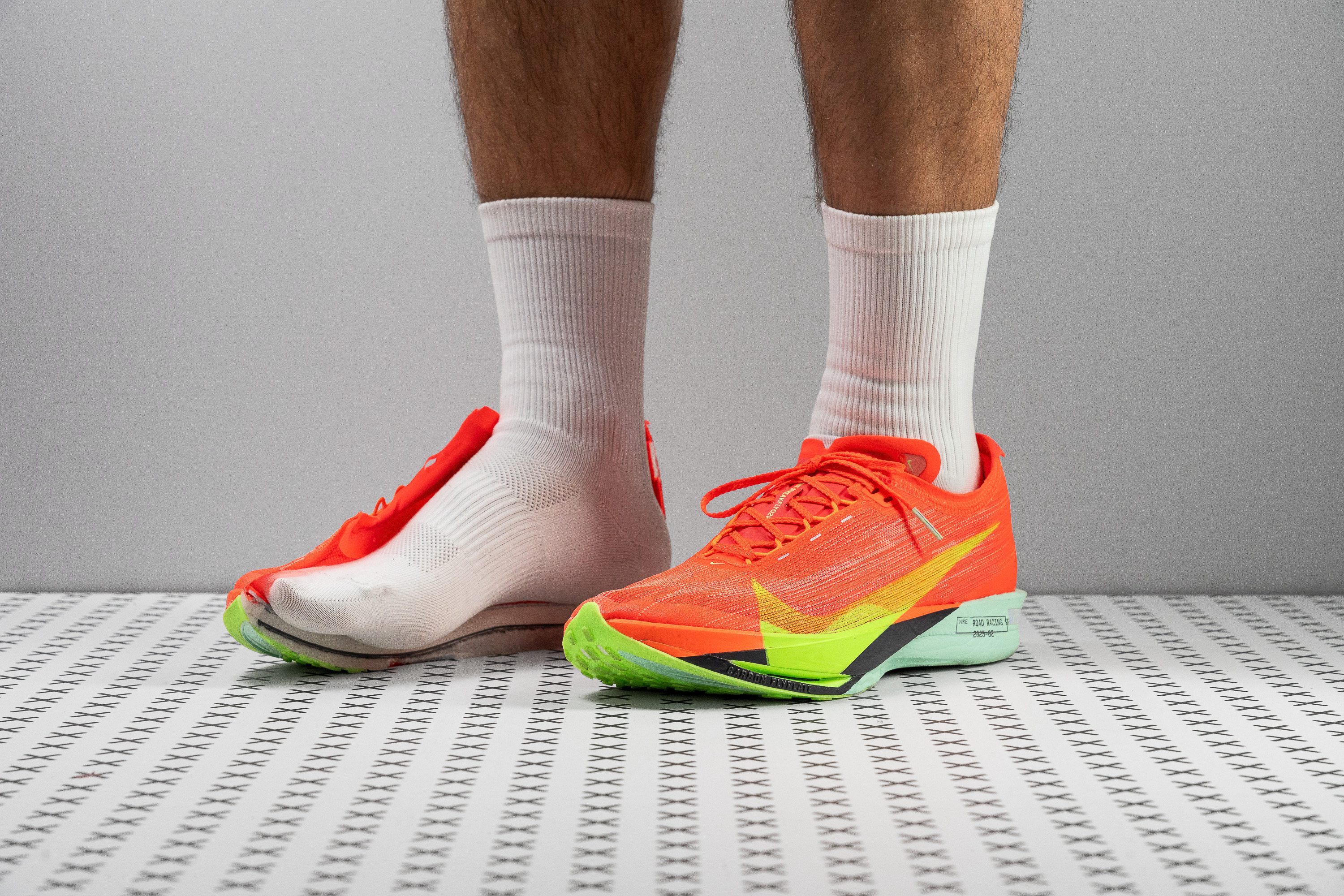






















































What makes it the best?
When it comes to tempo training, the Nike Streakfly 2 is the ultimate lightweight beast. Staying true to its name, we flew through the miles gracefully, with its exceptionally low weight and agile build. Proven by our lab results, this speedster is ready to support us through heated sessions with its comfortable ride and breezy upper.
Running with the Streakfly 2 feels like we’re barefoot! Our scales confirm a feathery 4.5 oz (128g) build, the lightest we’ve ever encountered in the lab. This airy build, plus the absence of a carbon plate, makes it highly agile, witnessed by the streets as we sprinted through turns effortlessly. Our lab confirms it’s 53.3% more flexible than average, making it comfortable even for relaxed runs.
What propels us aggressively is the ZoomX midsole, which we confirmed in our energy return test with solid scores of 76.3% in the heel and 77.9% in the forefoot. Sustaining heart-pumping paces feels more effortless with the dynamic ride the Streakfly 2 brings.
Further enhancing comfort is the ultra-breathable upper, as confirmed by our lab tests with a perfect score. We never felt our body heat trapped in, effectively preventing unwanted blisters and hotspots.
Due to its lack of structure, going beyond 10K distances feels uncomfortable because we’re working hard to stay stable.
Pros
- Feather-light build
- Ideal for 5K/10K races
- Wild, fun and fast
- Now features a carbon-fiber plate
- Much quicker than its predecessor
- Top-tier ZoomX foam
- Perfect for track workouts
- Not pricey all things considered
- Can stretch up to half marathon
- Grips well on dry and wet roads
Cons
- Not for heel strikers
- Only for short distances
- Narrow toebox
- Lacks stability
Tempo running shoes with the best versatility
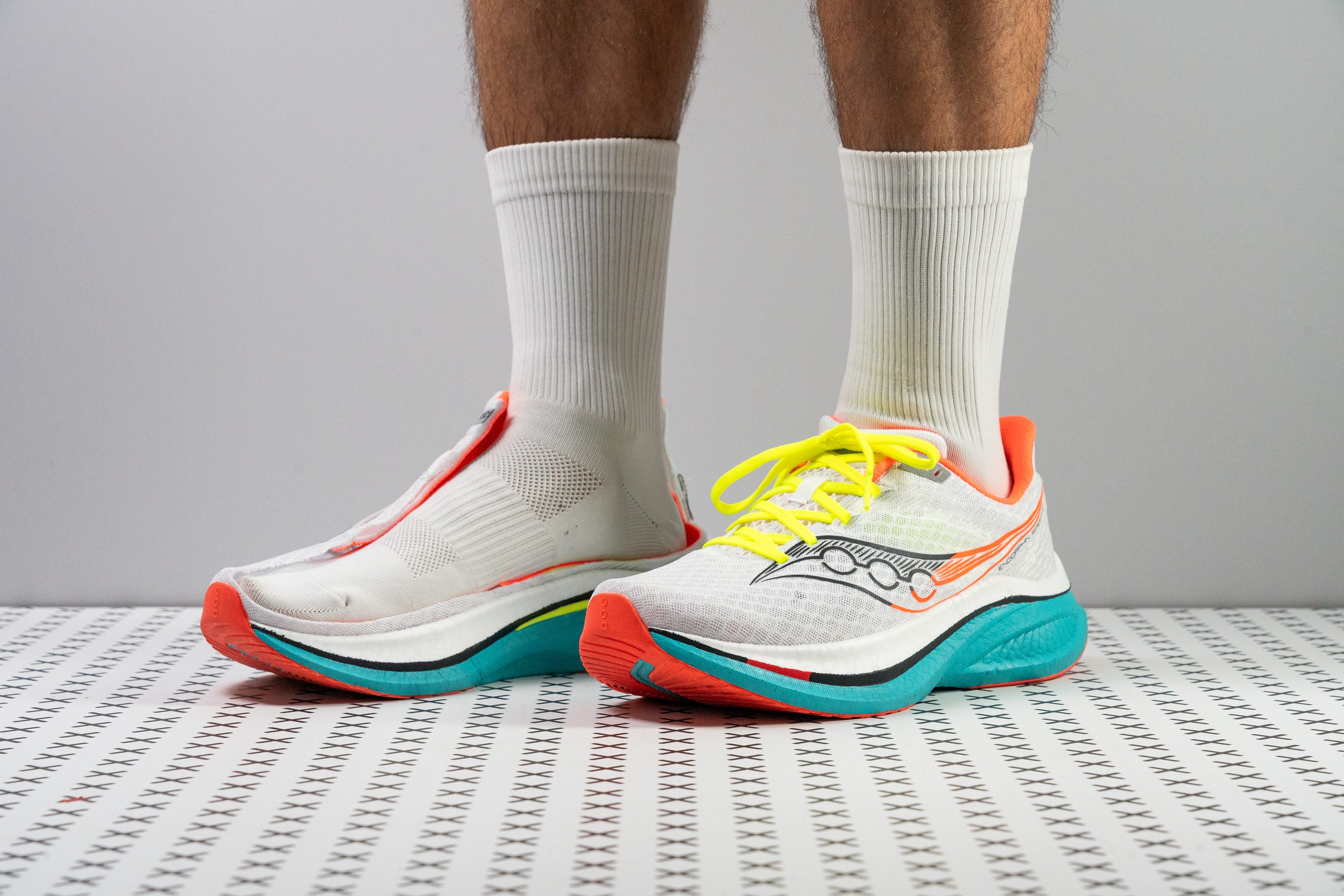













































What makes it the best?
The Saucony Endorphin Speed 5 feels good at any pace and distance, with its light and flexible design enhancing comfort and agility. Lab tests confirm its responsive and shock-absorbing midsole, yet it stands out for the SPEEDROLL geometry, enhancing smooth strides without stiffness. Therefore, it’s our best versatile tempo running shoe.
Whenever we want to speed up, the cushion springs into action immediately. In our energy test, we noted significantly high scores of 73.2% in the heel and 78.2% in the forefoot, assisting our toe-offs.
The SPEEDROLL geometry consists of a rocker and a nylon plate that boosts our forward momentum without stiffening the ride. It maintains freedom of movement and emerges 15.1% more flexible than average in our bend test. Together with its light 8.5 oz (241g) build, ES5 feels comfortable at any pace.
When it comes to endurance runs, the midsole took care of our muscles and joints by reducing the forces of each touchdown. Lab results capture our senses with great shock absorption ratings of 132/108 SA.
ES5 offers top-tier ventilation, but at the expense of durability. Those looking for a sturdier upper construction should skip this pair.
Pros
- Supershoe-like energy return
- Fantastic upper with top-notch ventilation
- Softer PWRRUN PB foam
- Endorphin Speed DNA still present
- Great lockdown
- Versatile for multiple paces
- Smooth SPEEDROLL rocker
- Roomier and taller toebox
- Can be used for racing too
- OG special colorway looks fantastic!
Cons
- Small price hike
- Less agile than predecessors
- Durability downgrade
Tempo shoes with the best traction






















































What makes it the best?
With our grippy ground control and its exceptional performance in lab tests, we awarded the ASICS Noosa Tri 16 as the tempo running shoe with the best traction. We felt prepared smashing our speed training regardless of the weather because of the shoes’ versatile outsole, responsive kick, and shock-absorbing cushioning in a lightweight package.
Starting with the main highlight, the ASICSGRIP rubber reassures us it’s one of the most reliable compounds by smashing our wet-condition test with a 0.79 friction score. Only a few shoes can match this level of traction, since it’s a whopping 68.1% grippier than average! Even if we pass through sharp turns and slippery streets, we have full confidence in the shoe.
We measured the stack height at a modest 32.8/26.9 mm using our caliper, leading to its impressively low weight of 7.7 oz (217g). However, we found it comfortable enough for multi-hour runs. We further tested how it reduces the impact of landings on our muscles, and it received solid shock absorption scores of 129/108 SA in the heel and forefoot, respectively.
Picking up the pace felt much easier in this shoe since the effort we put in is rebounded to our takeoffs. In our energy return test, the forefoot impressed with a 60.5% score. However, heel strikers won’t get the same experience and can only enjoy a 53.9% energy return score. If this is a dealbreaker, we recommend trying alternatives.
Pros
- Lightweight
- Exceptional grip
- Attention-grabbing aesthetic
- Gusseted tongue
- Comfortable upper
- Great for triathlon
- Really versatile
- Fantastic price point
- Breathability
Cons
- Upper longevity
- Minimal tongue padding
- Still not enough energy return
Best budget tempo running shoes
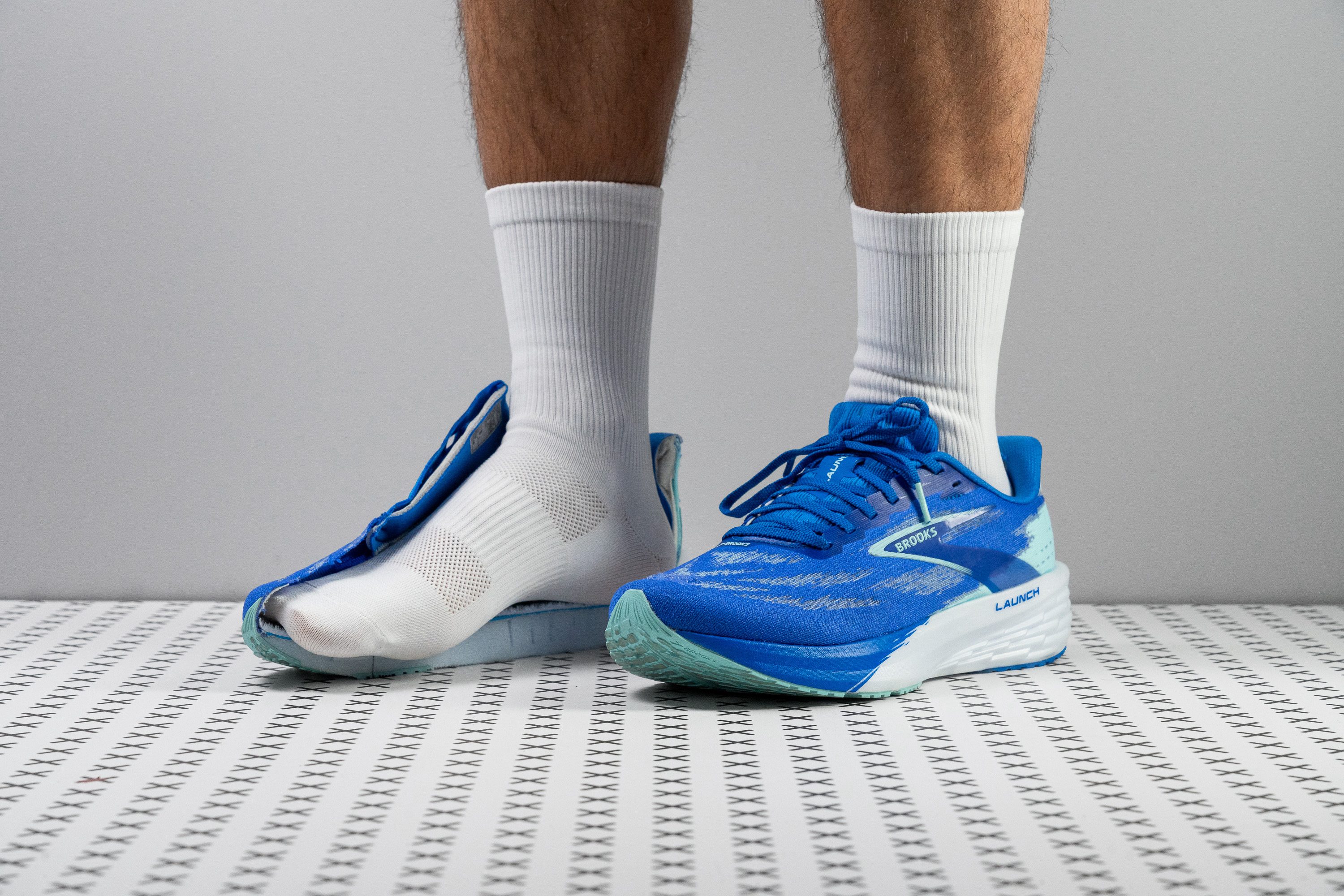

















































What makes it the best?
At $120, the Brooks Launch 11 offers impressive speed in our runs with a durable outsole and a dynamic cushion, all in a lightweight package. For the price, it’s way below the average speed trainer ($153) and has the qualities of more premium shoes. Our lab results cement its status as the best budget speed-training shoe.
Light in the pocket and on the feet, Launch 11 feels delightfully airy on foot. Our scales show it’s only 8.4 oz (237g), 10.6% below the average running shoe. This boosts our speed and agility, as our streets come to witness.
Adding value to the shoe is a bouncy midsole, with the forefoot notably impressing us with its 60.0% score. We enjoyed the touch of spring it added to our strides when we wanted to pick up speed.
The outsole emerges as a standout feature, surprising us with its dependable grip and impressive longevity. In our traction test, it managed to return an above-average 0.51 friction score. Despite extensive outdoor testing, we noticed minimal wear, backed up by lab data showing 20.0% less wear than average. No doubt, this budget shoe can last many training blocks.
However, we discovered Launch 11 isn't a good fit for broad-footed runners with its tight toebox. Those who prefer more room should go for less tapered shoes.
Pros
- Revamped nitrogen-injected midsole
- Great upper breathability
- Still fairly priced
- Snug and secure fit
- Improved for heel strikers
- Agile and nimble ride
- Works for daily miles and speed workouts
- Improved stability
Cons
- Price increase from v10
- Low-volume toebox
- Firm ride
- Minor weight gain
6 features of running shoes for tempo training
You can and should expect tempo running shoes to be:
- Responsive because anything else (boring and dull midsoles) would not propel you forward and help you reach higher paces
- Lightweight. They are usually lighter than daily trainers and heavier than race-day shoes
- OK for racing as well!
- More durable than race shoes because they endure all the tempo sessions that are a part of preparations for the big day
- Breathable because having sweaty feet while doing sprints or fartlek is on nobody’s wish list
- Stable, especially at fast paces and cornering.
Energy return and shock absorption of tempo running shoes
Responsiveness is all the craze, as it should be when it comes to speed. Running shoe with a high energy return most often feature premium foams. They are more responsive but also more expensive and less durable than the standard ones.
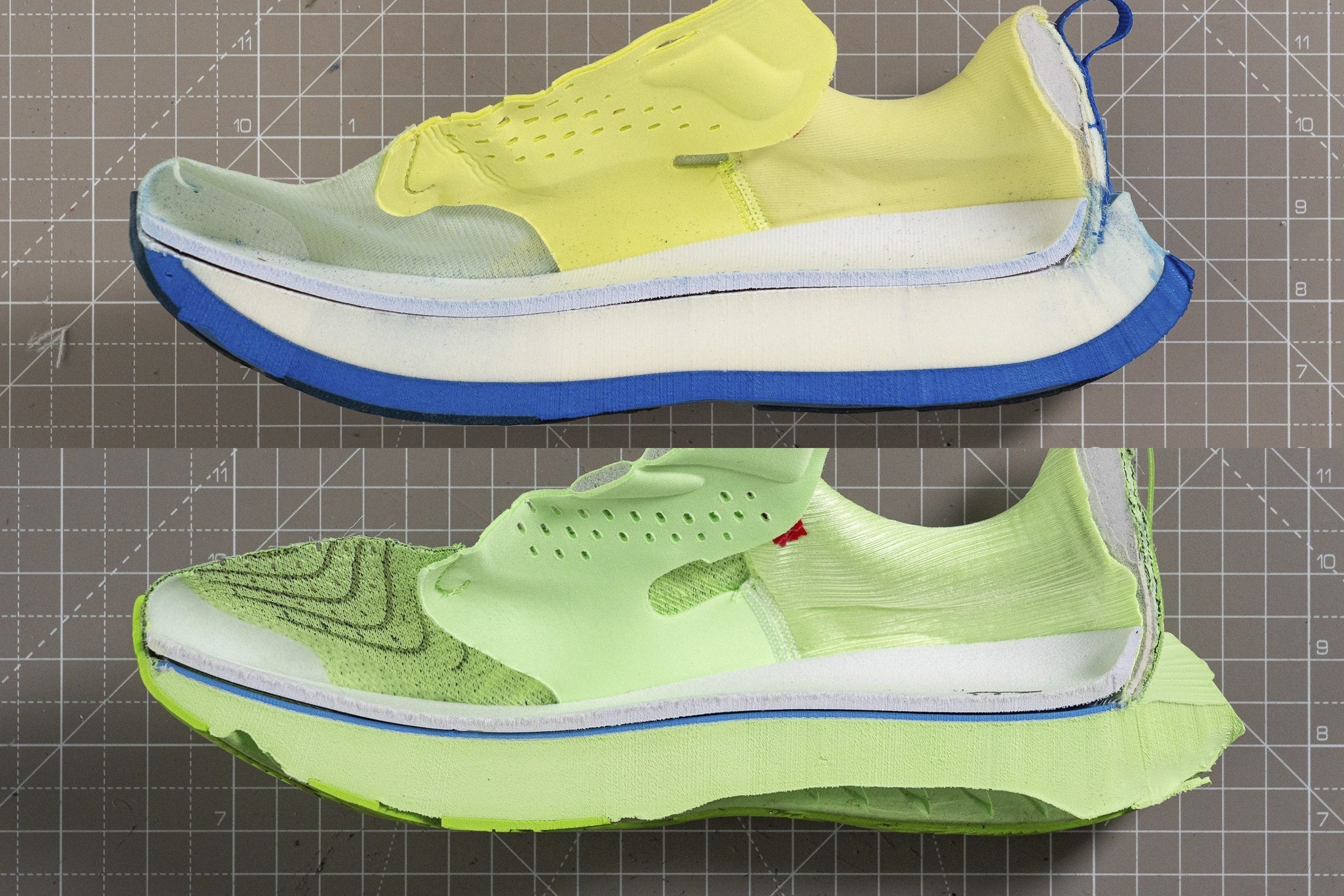
Fortunately, you don't have to figure out the foam type; you can look at the lab test results.
Testing the energy return and shock absorption of tempo running shoes
The higher the energy return, the better. Usually, the highest energy return is found in race-day shoes, and the lowest in daily trainers.
In the table, you can also see the shock absorption values. Just like with energy return, the higher the value, the better! One should always be aware of shock absorption because low SA values mean that more stress is sent towards your legs, because the midsole is not able to absorb it (well).
Weight of running shoes for tempo workouts
Looking at our lab database, these are the averages across 3 different categories (at the moment of writing this guide):
- Daily trainers: average weight 9.9 oz or 280g
- Tempo shoes: average weight 8.2 oz or 231g
- Race shoes: average weight 7.3 oz or 208.4g
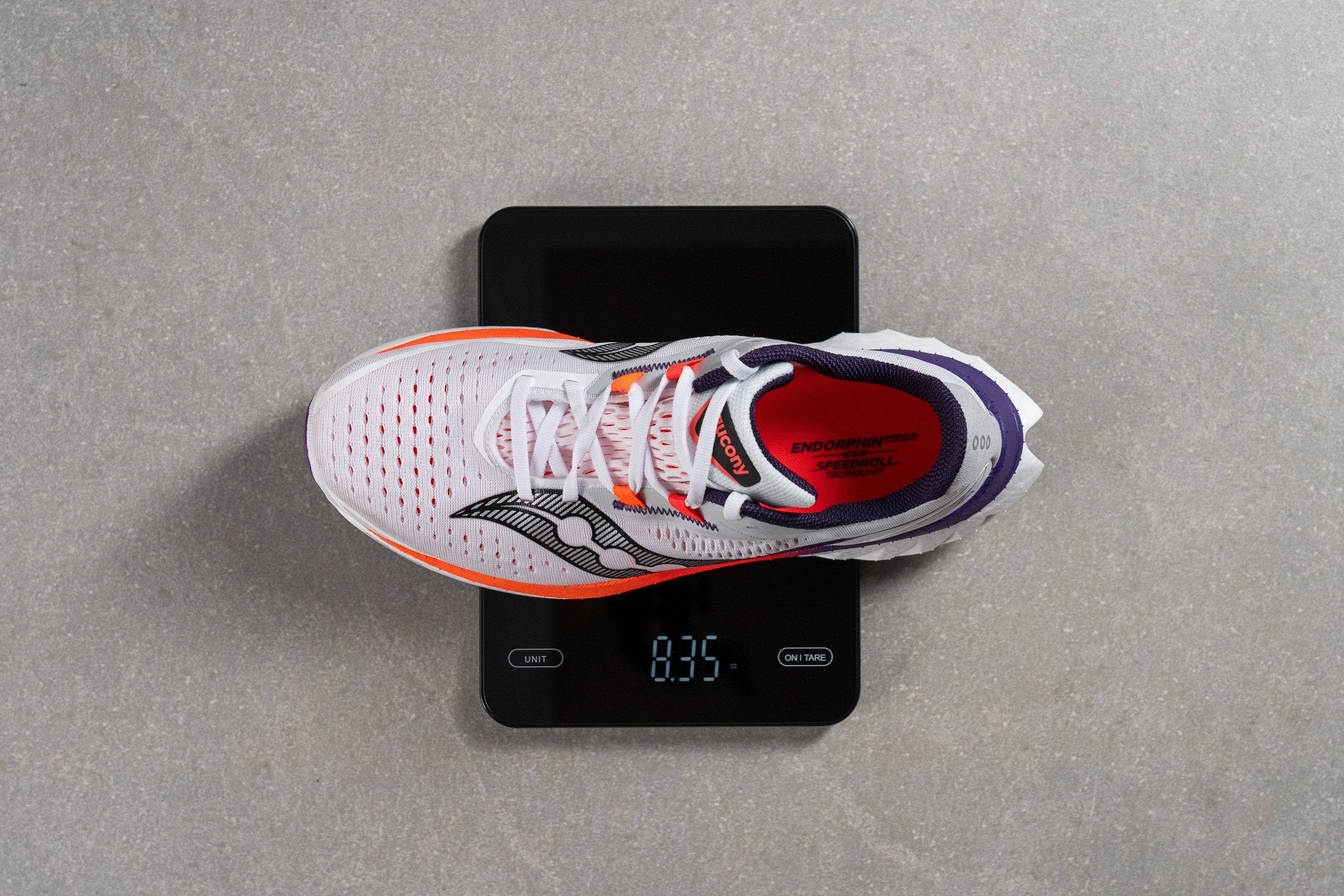
Of course, you should always look for a lighter tempo shoe, whenever possible, because heavy shoes weigh us down. It’s a matter of what you can live without because, to make shoes lighter, brands have to remove some things - chunks of the midsole, rubber parts on the outsole, heel tabs, padding in the tongue or around the heel collar, fancy insoles, and so on.
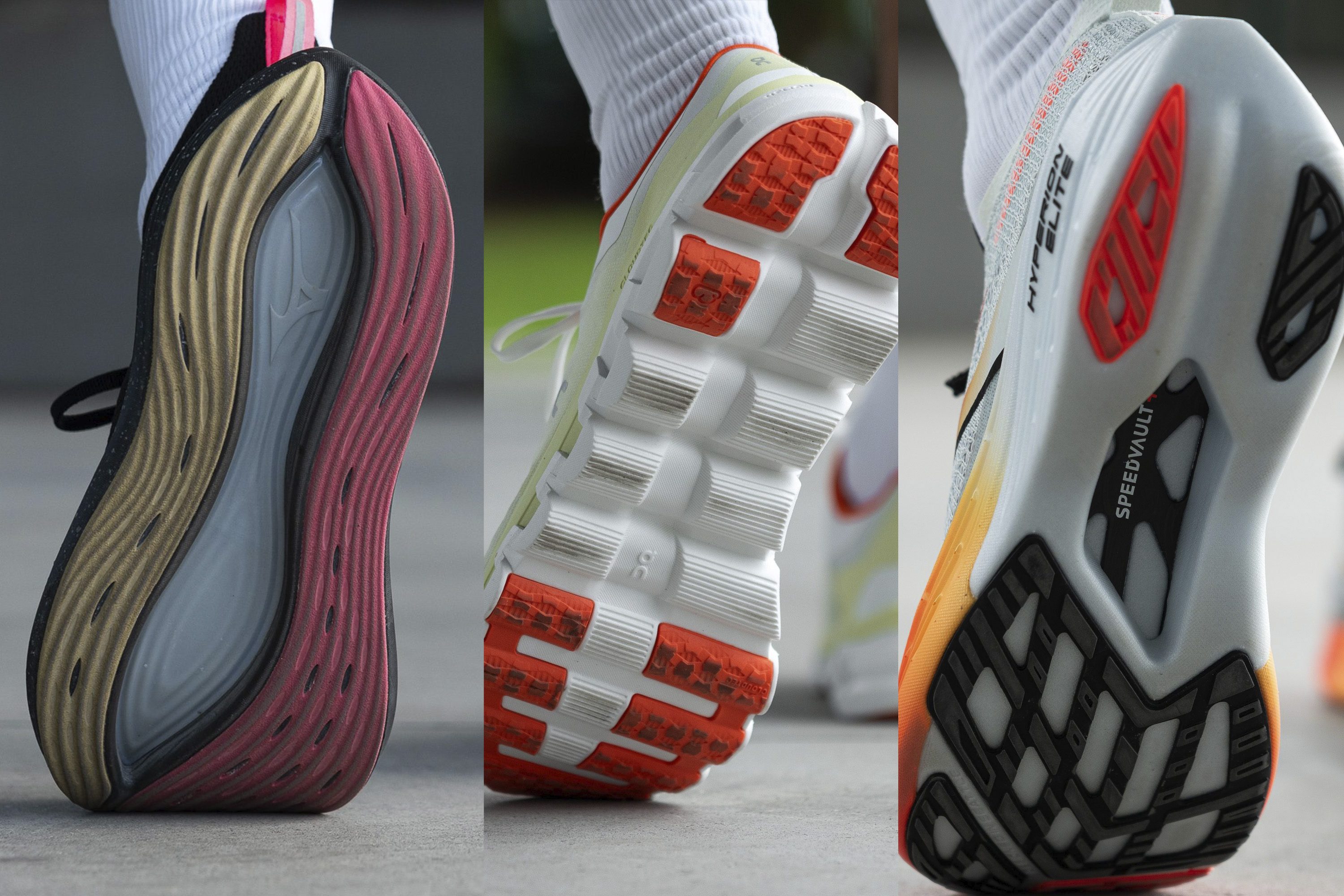
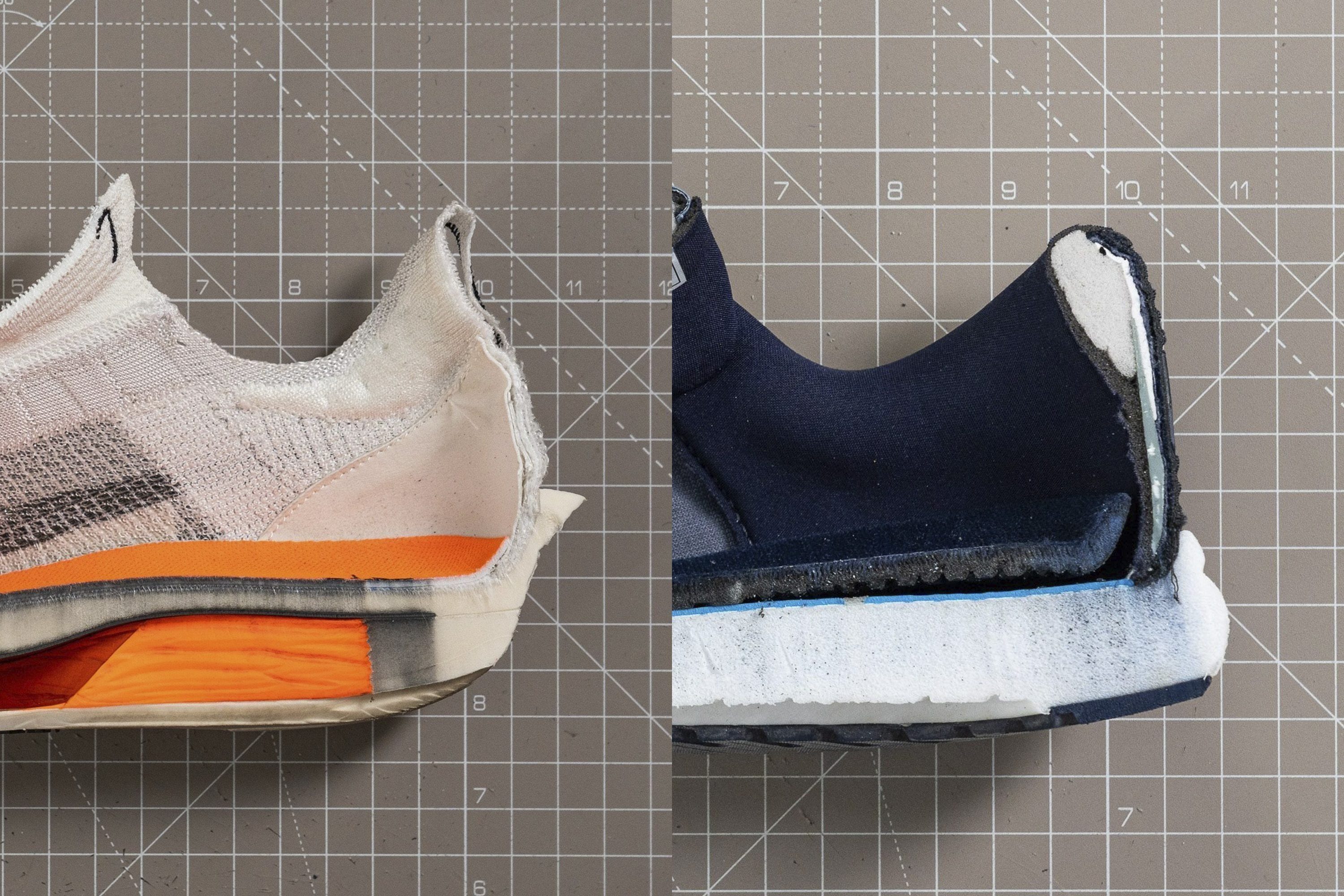
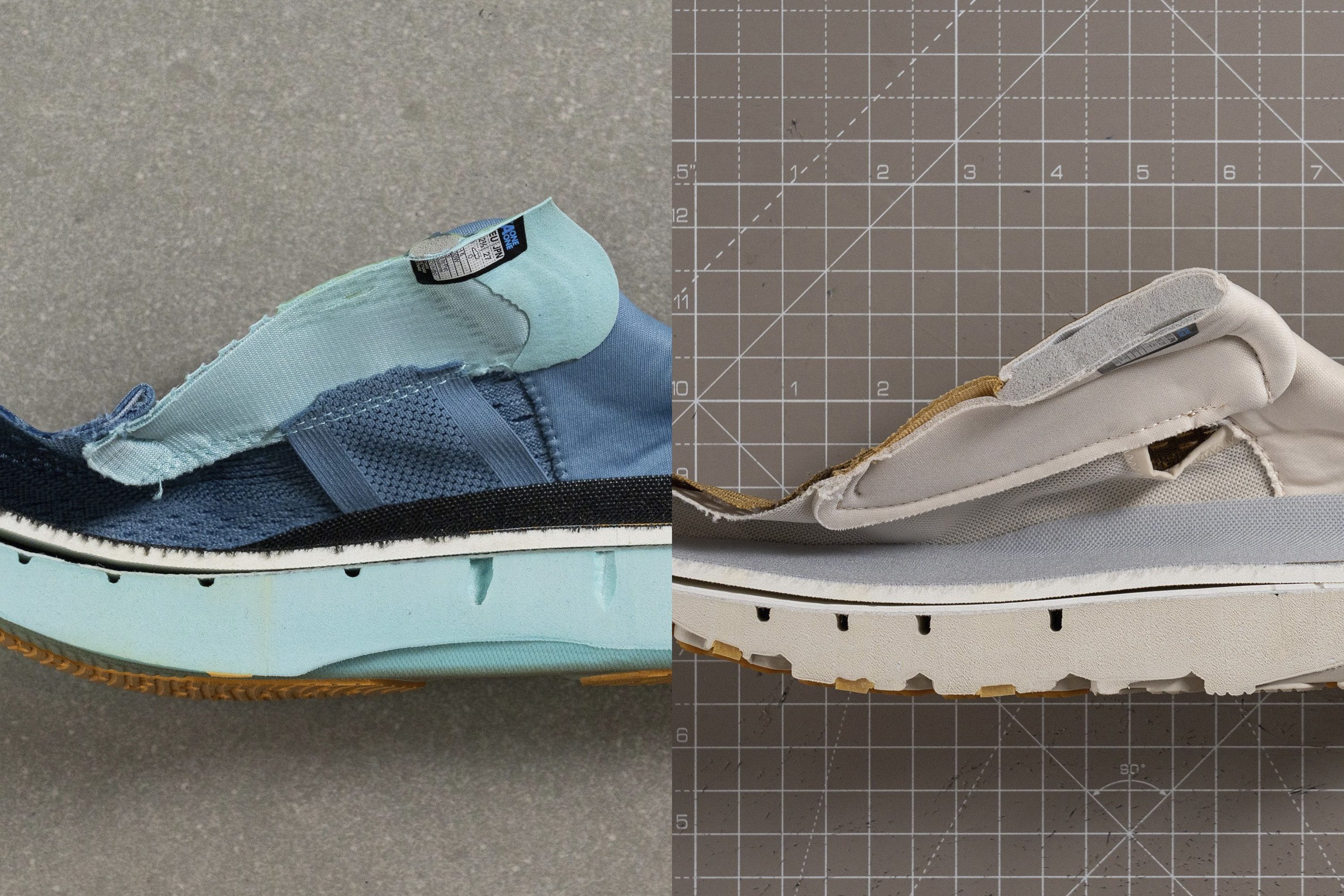
How durable are tempo running shoes
When brands tend to cut the weight, they also tend to make the rubber on the outsole thinner or even smaller so it covers less of the surface.
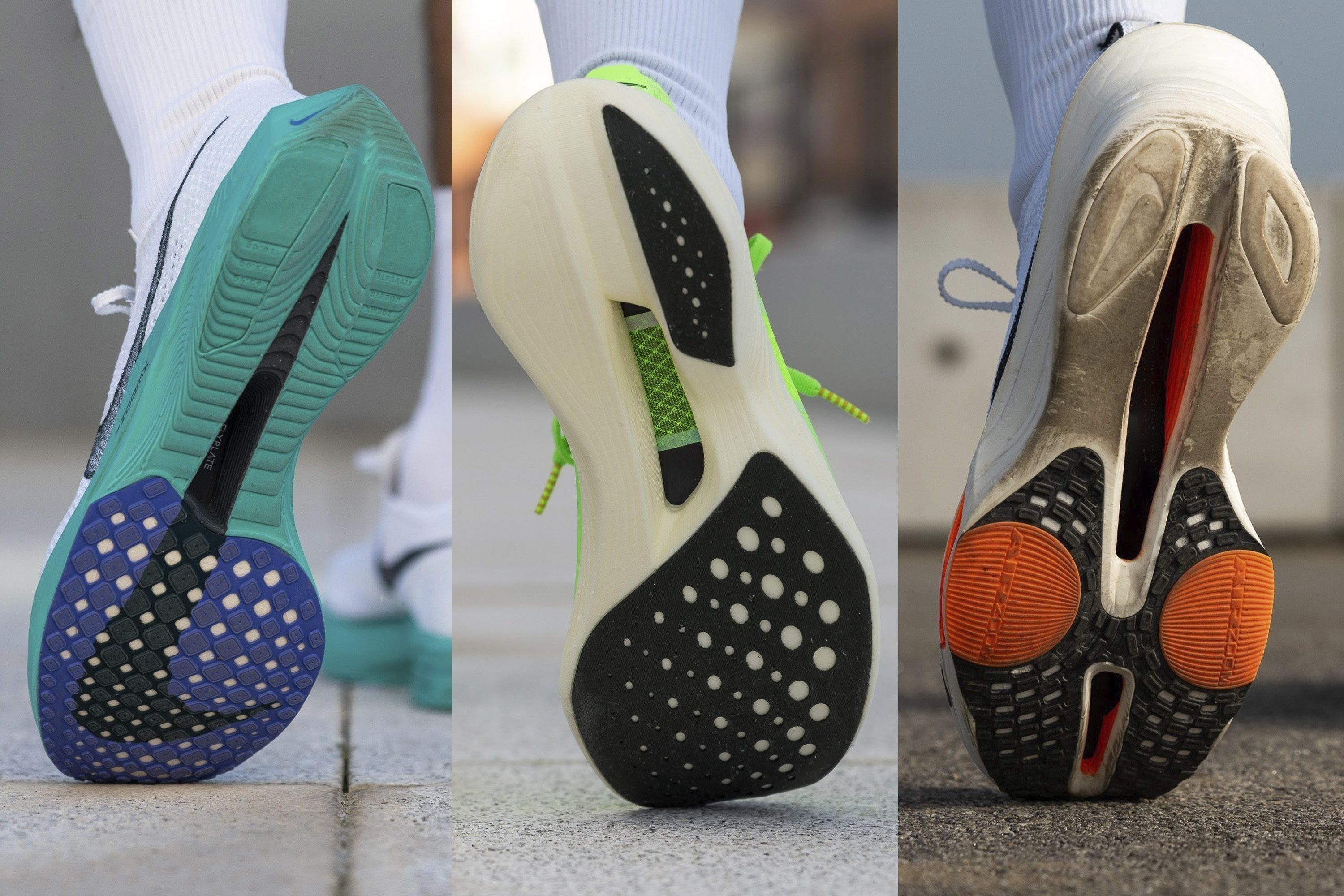
So, the rubber that we have at our disposal better be durable! In the lab, we press a dremel against it, always at the same pressure, RPMs and duration, and then we look at the damage.
Outsole durability test performed in RunRepeat lab
Then, we use a tire tread gauge to measure the depth of the dent. The shallower the dent, the more durable the outsole and vice versa.
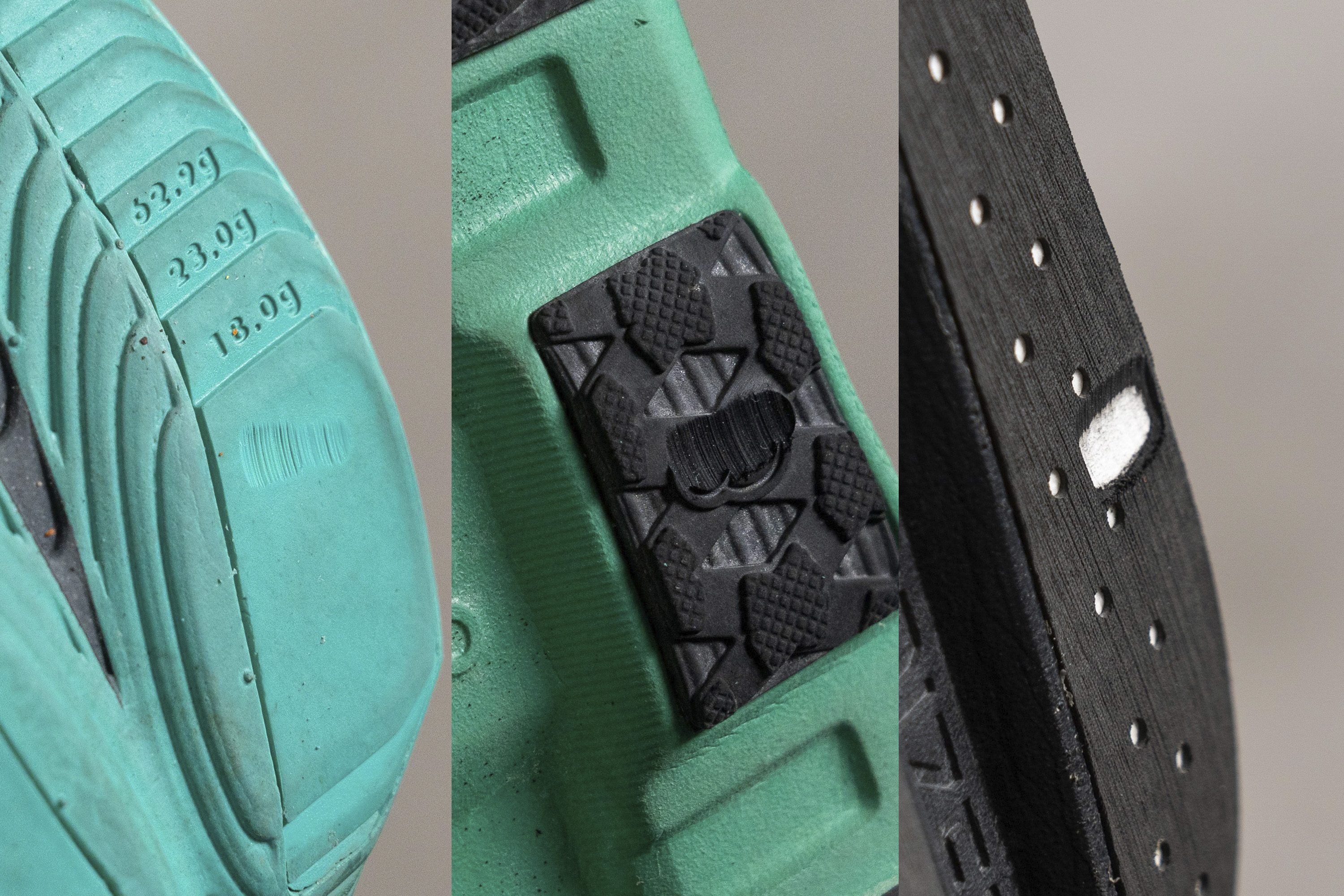
We also test the durability of the toebox and heel padding using the dremel. But, in these 2 cases, we can’t precisely measure the depth because it’s fabric, loose threads and so on. So, we assess the damage on a 1-5 scale, where 1 is the least durable.

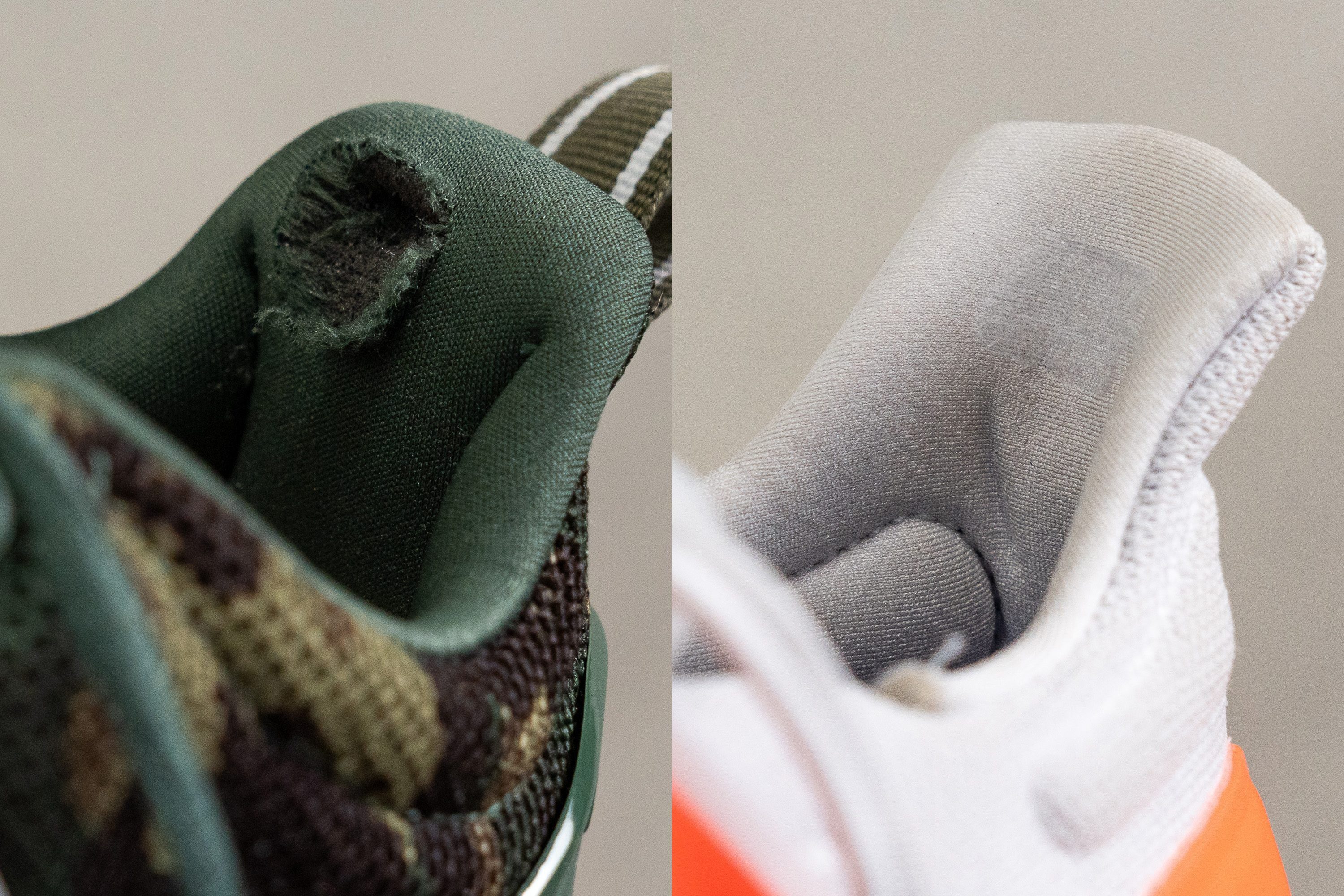
Can you race in tempo running shoes?
Of course! Many running shoes are made for speedwork AND competitions!
|
Using tempo running shoes for racing |
|
|
Pros |
Cons |
|
Saving money because you’re using 1 shoe for 2 purposes |
Potentially getting a worse finish time because you’re not using a dedicated (maybe even premium) race shoe |
|
You’re already very familiar with the shoe because you’re training in it, no adaptation period |
Premium foams are more often found in race shoes than tempo shoes and, as such, race shoes more often have leg-saving features than tempo shoes |
|
Some race shoes are so not durable they should be kept for races only, but no such worries with tempo running shoes |
|
Breathability of tempo running shoes
Tempo running shoes are, when it comes to breathability, between the daily trainers and dedicated racers. Race-day shoes cut the weight in all the possible ways, including making the upper thin and airy. Daily running shoes often feature knit upper which are very soft, cozy, and not so breathable. And tempo shoes are somewhere in between.
Testing the breathability of tempo shoes in RunRepeat lab
We test the breathability of all shoes in our shoe lab. We do it by pumping the smoke into the shoes and then observing: where the smoke comes out? How fast? How much of it is pumped through the upper? Based on this, we assign a 1-5 breathability rating to each shoe. 5 stands for the most breathable and 1 for the least breathable (or winter-friendly).
Let’s look at the fresh lab data:
- Avg breathability of daily trainers: 3.6/5.0
- Avg breathability of tempo running shoes: 4.3/5.0
- Avg breathability of race running shoes: 4.7/5.0
We also examine the uppers under the microscope to discover if there are any ventilation holes, how big they are, if they are for show only or they actually work, are there patches of another fabric which means there are 2 layers on the upper, and so on.
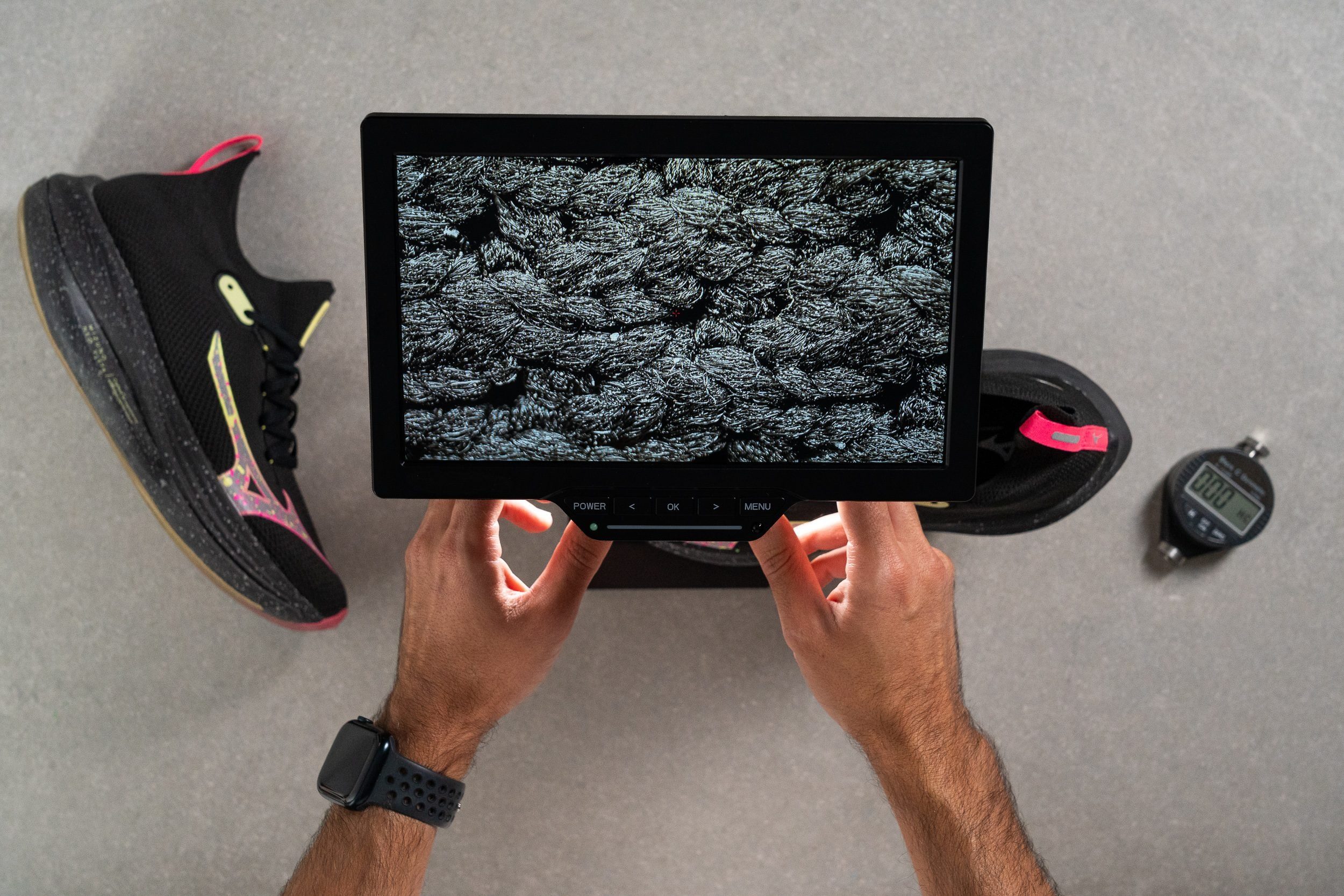
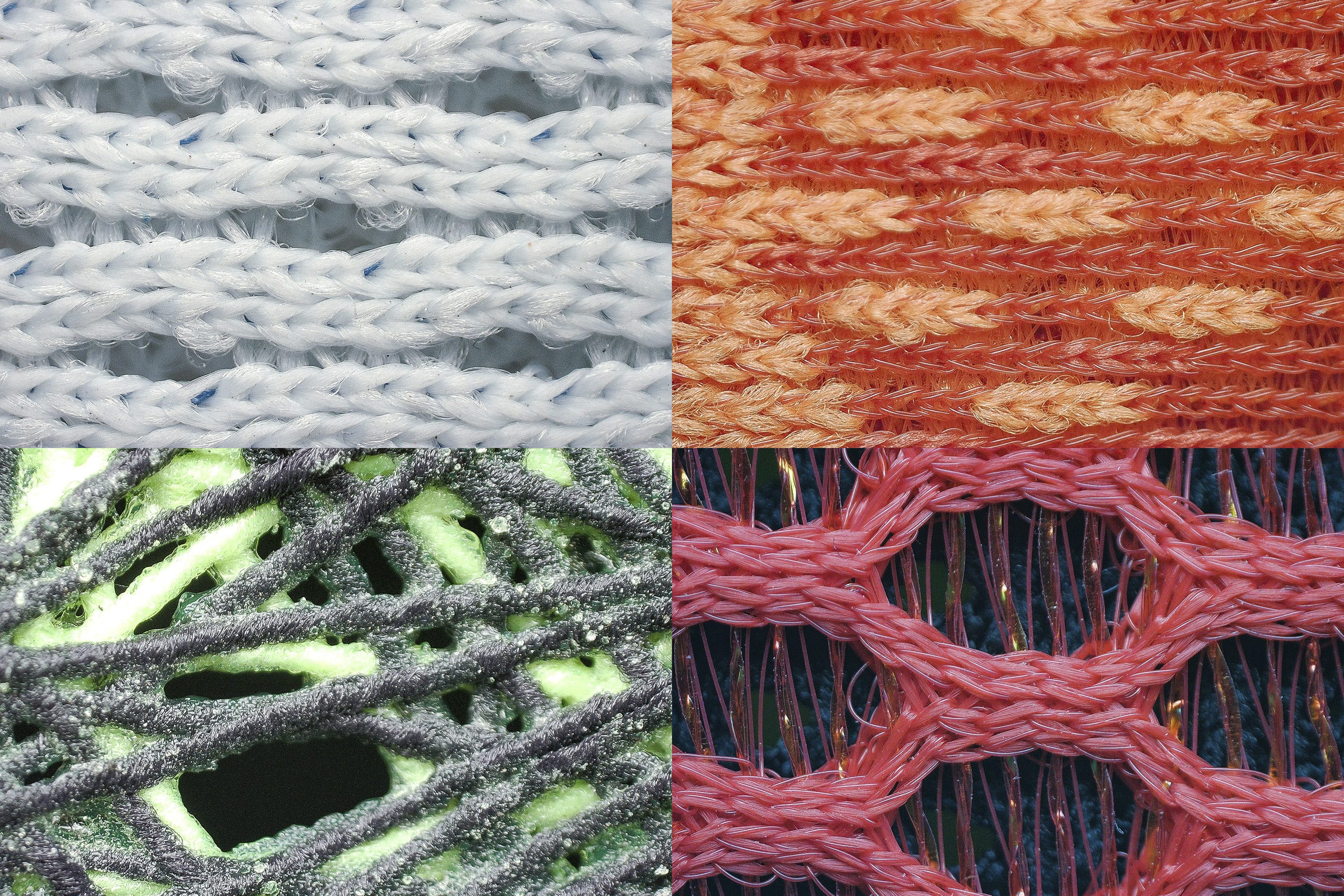
Wobbling while cornering is a NO
Shoes are getting higher and runners still prefer softer midsoles. Combining height and softness can go bad if the platform is narrow. Then, it’s not stable, especially if the shoe does not feature a full-length rubber outsole (or at least a decent all-footstrikes surface coverage).
To find out how high off the ground tempo running shoes are, we cut them in half and measure their forefoot and heel stack heights.
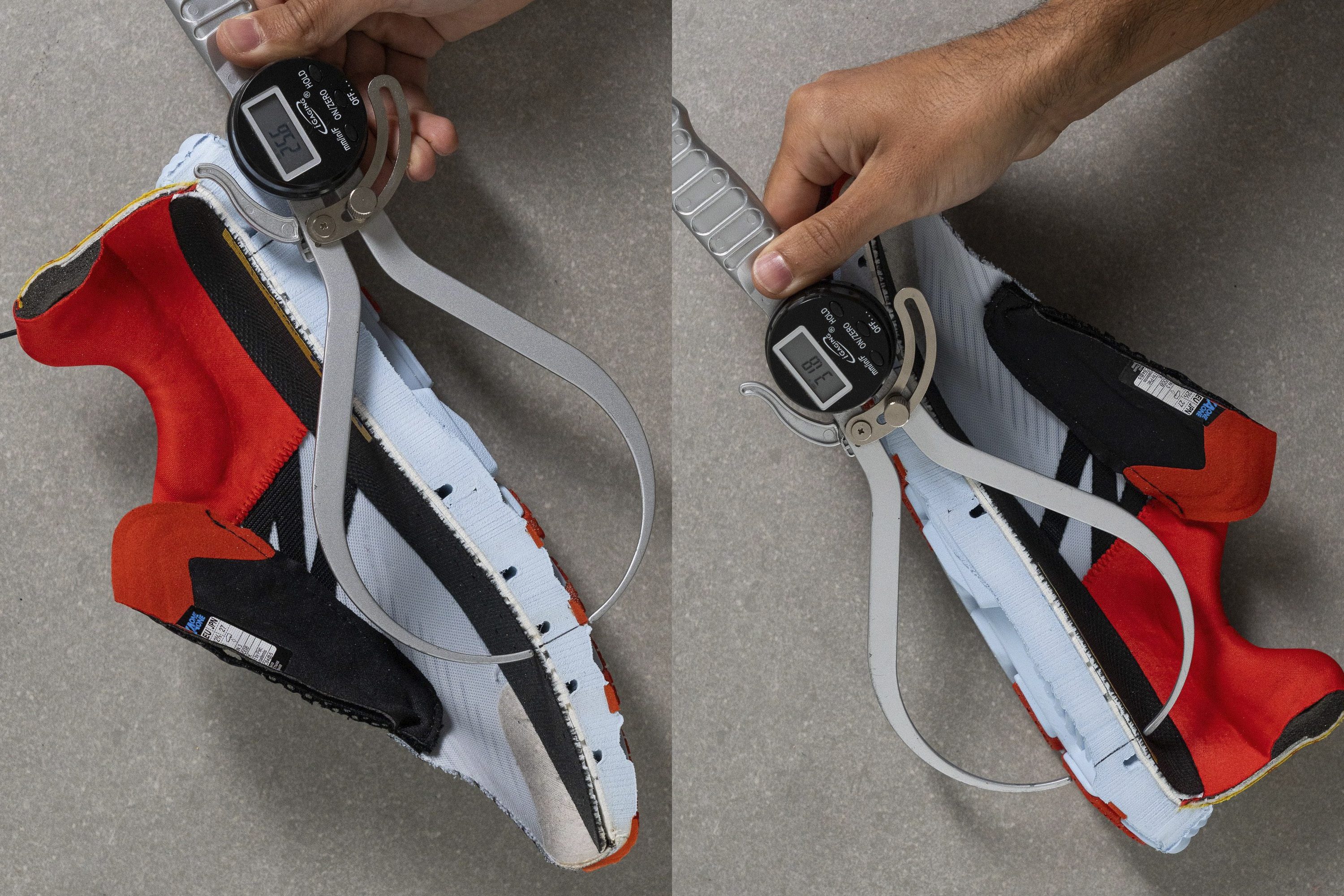
In the lab, we also measure the softness of each running shoe midsole. We do it by cutting the shoe in half and sticking a shore A durometer into the foam.
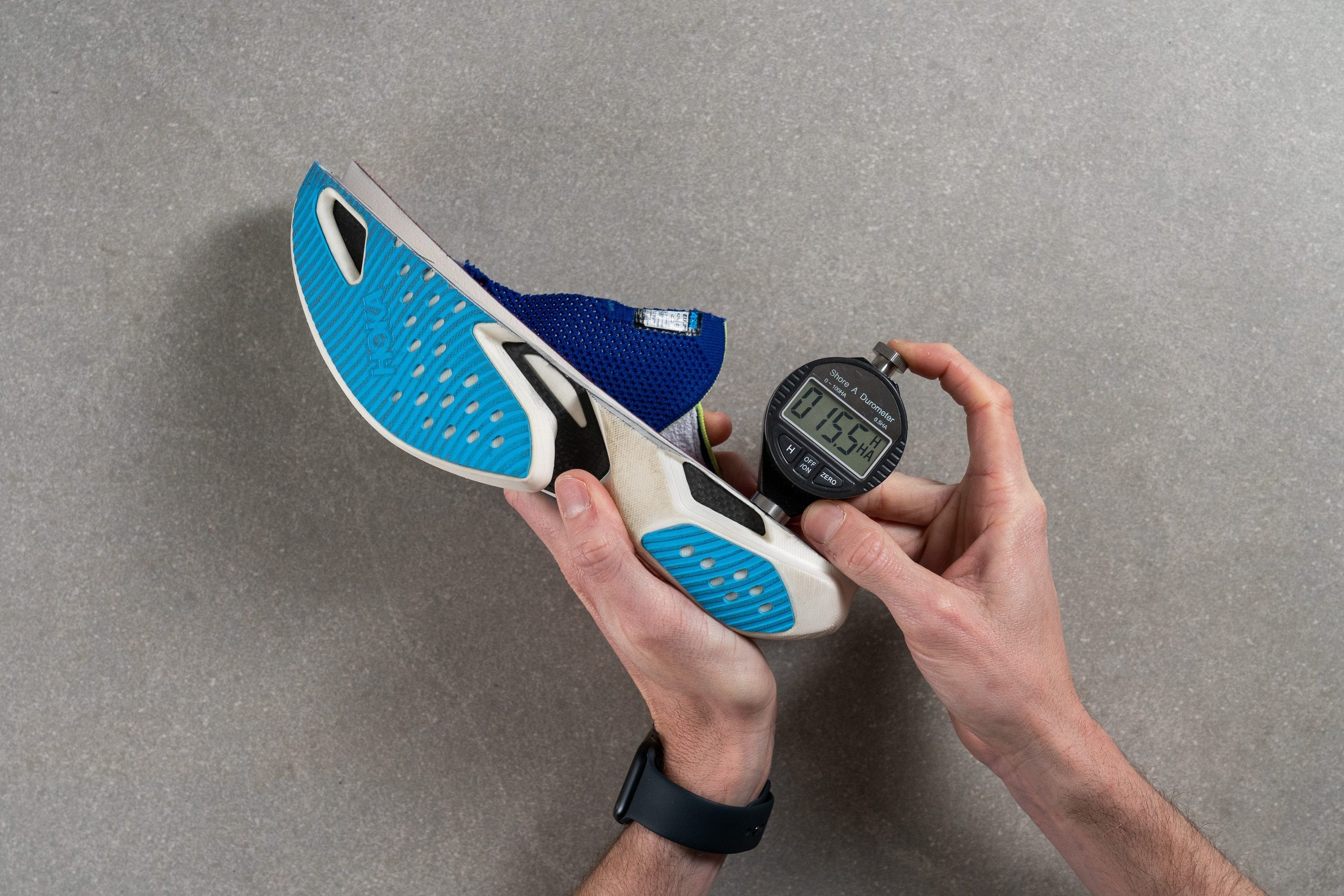
With this test only, you can look for the softest or firmest running shoes for speedwork.
But, to discuss the instability, we have to look at the width of the base. Wider bases mean more planted landings and toeoffs.

This especially applies to heel strikers because shoes can get very narrow at the heel.

Here, we list tempo running shoes with the widest midsoles, prioritizing the heel:
How stiff are tempo running shoes?
When plated (nylon or carbon-fiber), very! However, not all tempo shoes are plated. The magic formula for insane energy return is to have a soft midsole made of a premium foam with a carbon-fiber plate. But, that is not everyone’s cup of tea.
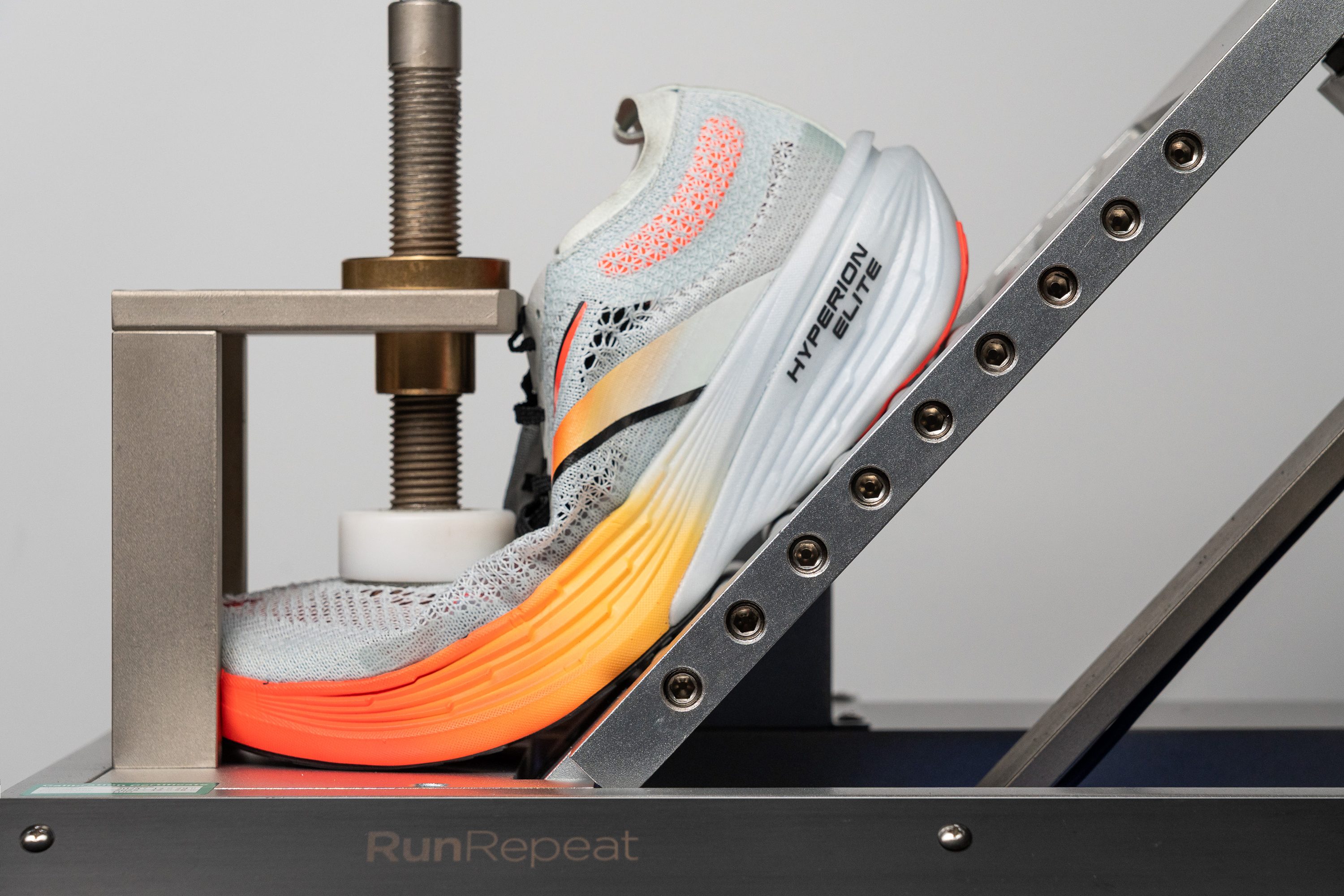
We test the stiffness of a running shoe by bending it to 30 degrees - the more force we need to do that, the stiffer the shoe. Less force and it’s a more flexible running shoe.
To get some context, the average stiffness of a tempo running shoe is 14.7N, while daily trainers show 13.9N on our machine's display on average. Race shoes are the stiffest and, on average, the machine needs a force of 22.6N to bend them to 30 degrees.
In case you prefer a more flexible, natural ride, these shoes are worth checking out:

